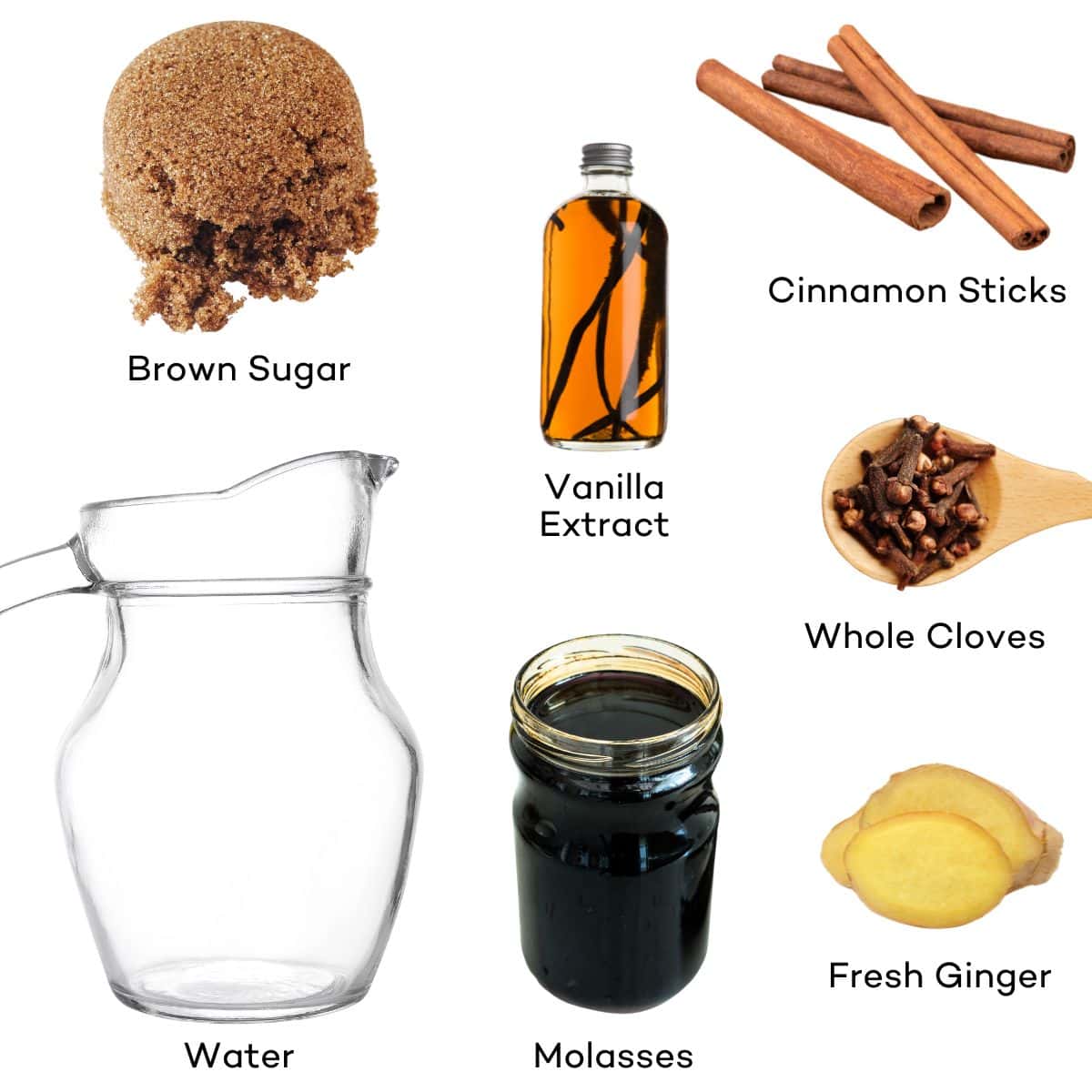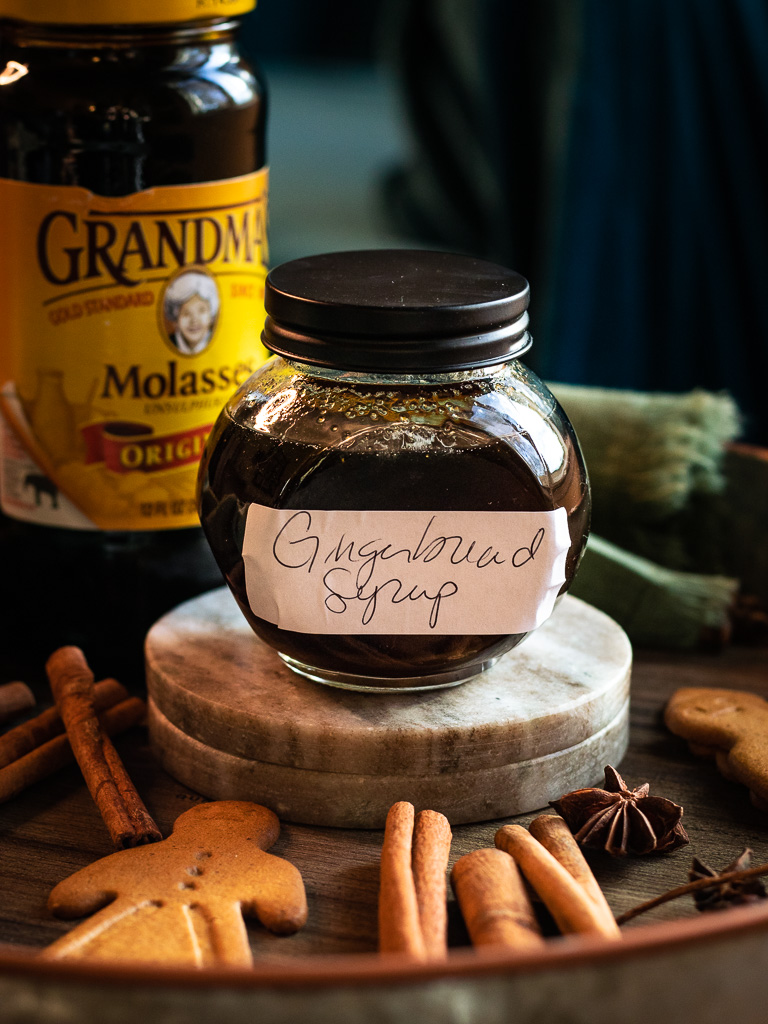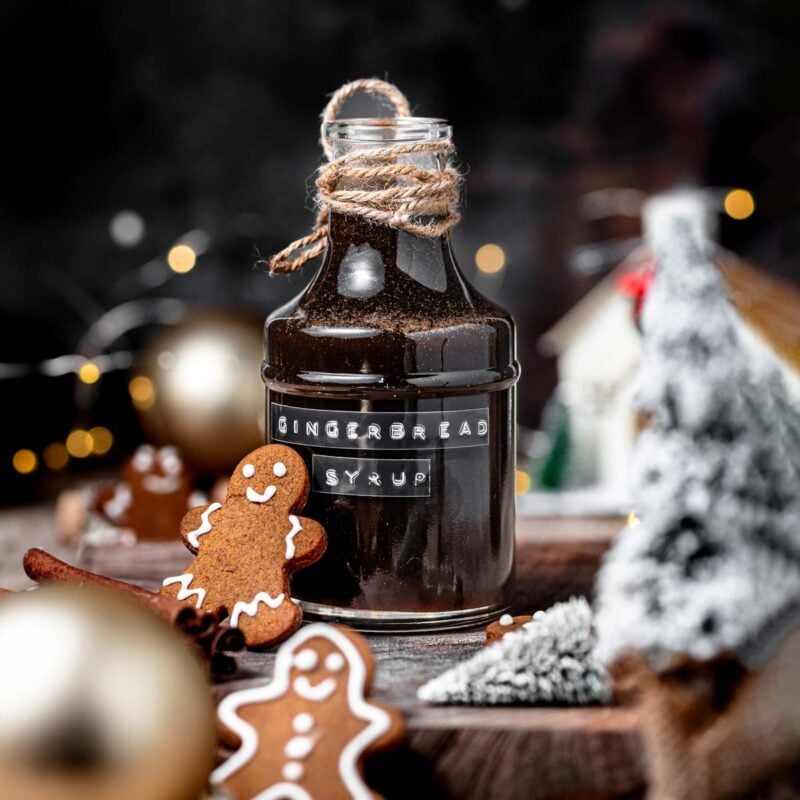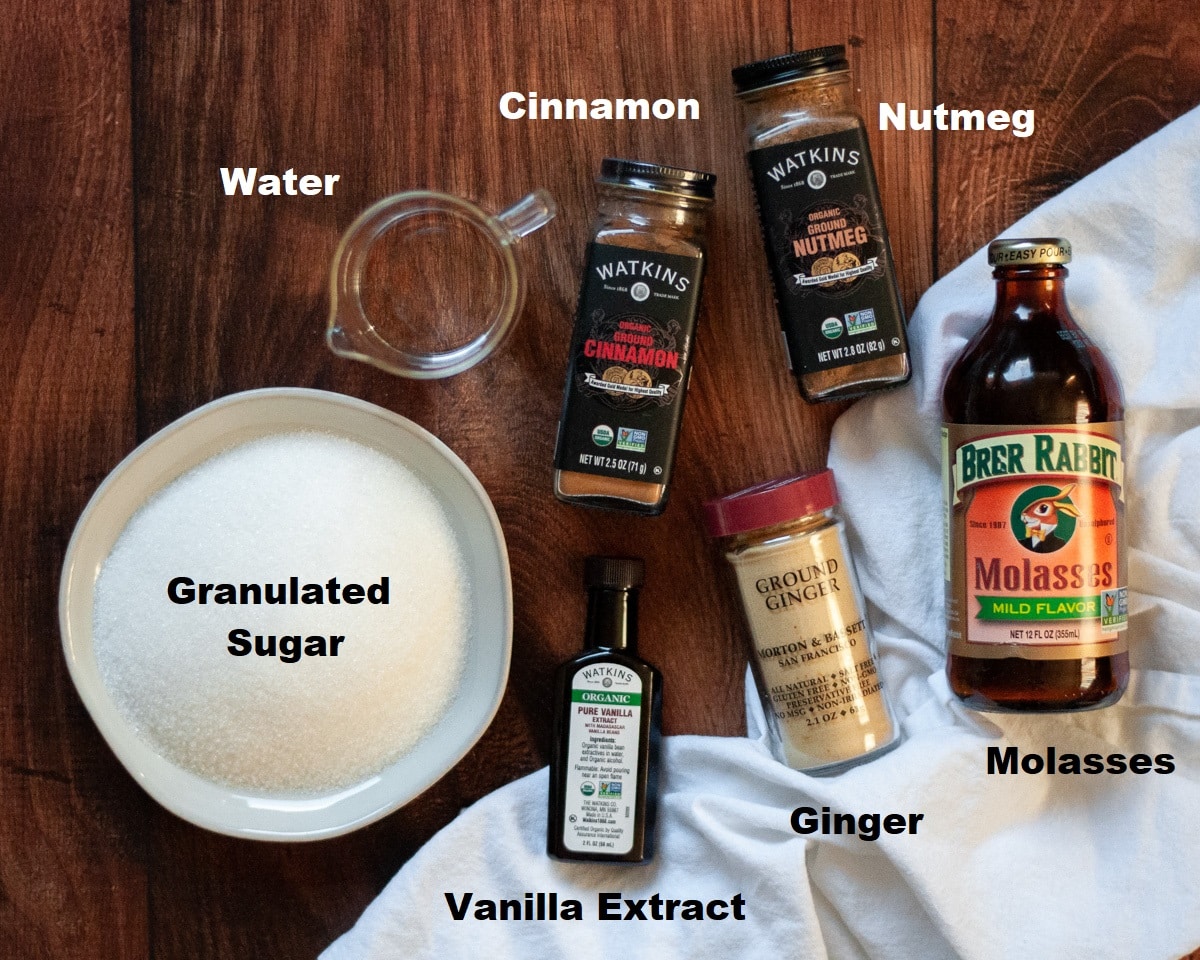Gingerbread simple syrup captures the warm, spicy essence of classic gingerbread cookies in a versatile liquid form. Infused with ginger, cinnamon, cloves, nutmeg, and molasses, this syrup transforms ordinary beverages and recipes into holiday delights. Ideal for your website’s syrup recipes section, this syrup not only adds sweetness but also layers of aromatic spice that evoke the magic of the season.

A jar of homemade gingerbread simple syrup surrounded by spices like cinnamon and ginger.
The Rich History and Evolution of Gingerbread Simple Syrup
Gingerbread has a storied past, dating back over a millennium, with its syrup form emerging as a modern adaptation for beverages and desserts. The term “gingerbread” originally referred to preserved ginger, evolving in medieval Europe into spiced breads and cookies. By the 11th century, Crusaders brought ginger from the Middle East to Europe, where it was prized for its medicinal properties and exotic flavor. In England, gingerbread became a fairground treat, often shaped into figures and gilded with gold leaf for nobility. Queen Elizabeth I is credited with popularizing gingerbread men, commissioning bakers to create likenesses of her courtiers.
The syrup variation draws from gingerbread’s core ingredients: ginger, molasses, and warm spices. Molasses, a byproduct of sugar refining, became integral in the 17th century when British colonies in the Caribbean produced it abundantly. Early American recipes, like those in Amelia Simmons’ 1796 cookbook “American Cookery,” featured gingerbread cakes sweetened with molasses and pearlash (an early leavening agent). The syrup form likely originated in the 20th century, inspired by simple syrups used in cocktails since the 1800s. Bartenders began infusing syrups with seasonal flavors, and gingerbread syrup gained traction in the 2000s with the rise of craft cocktails and specialty coffees.
Today, it’s a holiday staple, evoking Dutch “pepernoten” or German “Lebkuchen,” but in liquid form for versatility. For more on gingerbread’s fascinating timeline, visit Wikipedia’s gingerbread page. This evolution from ancient spice trade to modern mixology highlights how simple ingredients create enduring traditions.
Gingerbread’s cultural significance extends beyond Europe. In Asia, ginger has been used medicinally for thousands of years, with Chinese texts from 2800 BCE praising its warming properties. As trade routes expanded, gingerbread variations appeared worldwide—Swedish “pepparkakor” thin cookies, Polish “piernik” honey-spiced cakes, and Russian “pryanik” stamped treats. The syrup adaptation democratizes these flavors, allowing anyone to infuse drinks with global heritage.
In the U.S., gingerbread houses became popular in the 19th century, inspired by the Brothers Grimm’s “Hansel and Gretel.” Syrup versions amplify this whimsy, turning everyday items into festive experiences. From medieval monasteries to contemporary cafes, gingerbread simple syrup bridges centuries of culinary innovation.
Unpacking the Health Benefits of Gingerbread Simple Syrup
While indulgent, gingerbread simple syrup offers surprising health perks from its natural ingredients. Ginger, the star spice, contains gingerol, a compound with anti-inflammatory and antioxidant effects that may ease nausea, reduce muscle pain, and support digestion. Cinnamon aids blood sugar regulation and boasts antimicrobial properties, potentially lowering heart disease risk. Cloves provide eugenol, which fights bacteria and inflammation, while nutmeg offers manganese for bone health.
Molasses, unlike refined sugar, retains minerals from sugarcane, including iron, calcium, and magnesium—beneficial for anemia prevention and energy boosting. When used sparingly, the syrup can enhance beverages without excessive calories, making it a healthier alternative to artificial flavorings.
However, moderation is key due to sugar content. Opt for brown sugar versions for added nutrients. Studies suggest ginger-based syrups may alleviate cold symptoms, aligning with traditional remedies. For wellness-focused readers, link to our healthy syrup alternatives blog.

Key ingredients for gingerbread simple syrup, including molasses, ginger, and spices.
Ginger’s bioactive compounds also support immune function, with research indicating potential antiviral effects. Combined with cinnamon’s ability to improve insulin sensitivity, this syrup could fit into balanced diets. Nutmeg and cloves add fiber and vitamins, rounding out a nutrient profile that’s more than just sweet.
In homemade versions, control sugar levels to maximize benefits. Compared to store-bought syrups laden with preservatives, DIY gingerbread syrup is a wholesome choice for flavoring without artificial additives.
Essential Ingredients for Making Gingerbread Simple Syrup
Crafting gingerbread simple syrup requires basic, flavorful components. Here’s a breakdown for a batch yielding about 1-1.5 cups.
- 1 cup water: The base for dissolving sugars.
- 1 cup brown sugar: Provides caramel notes; light or dark for varying intensity.
- ¼ cup molasses: Adds deep, earthy sweetness; blackstrap for robust flavor.
- 2-3 inches fresh ginger: Peeled and sliced; imparts zing.
- 2 cinnamon sticks: Or 1 tsp ground; for warmth.
- ½ tsp ground cloves: Earthy spice.
- ½ tsp ground nutmeg: Nutty undertone.
- 1 tsp vanilla extract: Optional, for smoothness.
These create a balanced, aromatic syrup. Source organic spices for purity—check this guide on spice sourcing.
Fresh ginger is key for potency; dried can substitute but lacks vibrancy. Molasses varieties influence color and taste: Mild for subtlety, robust for boldness.
Step-by-Step Guide to Preparing Gingerbread Simple Syrup
This quick recipe takes 10-20 minutes, perfect for beginners.
- Combine Ingredients: In a saucepan, mix water, brown sugar, molasses, ginger, cinnamon, cloves, and nutmeg.
- Heat and Simmer: Bring to a boil over medium heat, stirring to dissolve sugar. Reduce to simmer for 10-15 minutes, infusing flavors.
- Strain and Cool: Remove from heat, add vanilla. Strain through a fine mesh to remove solids. Cool before bottling.
- Store: Pour into a glass jar; refrigerate up to 2-4 weeks.
For visuals, see this YouTube tutorial on flavored syrups.

A labeled bottle of gingerbread syrup with festive decorations.
Tips: Adjust spice levels; simmer longer for thicker syrup. Avoid overboiling to prevent crystallization.
Creative Uses for Gingerbread Simple Syrup in Everyday Recipes
Versatile beyond expectation, this syrup shines in various applications.
- Beverages: Stir into coffee for a gingerbread latte or tea for spiced warmth.
- Cocktails: Mix with bourbon for a holiday old fashioned or vodka for a gingerbread martini.
- Desserts: Drizzle over ice cream, pancakes, or oatmeal; use in cake glazes.
- Savory Twists: Glaze roasted veggies or ham for sweet-spicy contrast.
Explore our cocktail ideas page for recipes.
In baking, substitute for maple syrup in muffins. For non-alcoholic drinks, add to lemonade for a spicy twist.
Exciting Variations and Customizations for Your Syrup
Tailor the syrup to preferences:
- Vegan Version: Use maple syrup instead of molasses if needed.
- Spicier Take: Add allspice or cardamom for depth.
- Sugar-Free: Use erythritol and molasses alternatives.
- Boozy Infusion: Steep with rum post-simmer for adult versions.
Browse more in our syrup variations section.

Festive gingerbread syrup bottle with gingerbread cookies and lights.
Experiment with orange zest for citrus notes or black pepper for heat.
Storage Tips, Shelf Life, and Preservation Methods
Store in airtight glass jars in the fridge for 2-4 weeks. Freeze in ice cube trays for longer—up to 3 months. Signs of spoilage: Mold or off odors.
For gifting, label with dates and ingredients. Canning extends shelf life to a year.
Perfect Pairings: Foods and Drinks That Complement Gingerbread Syrup
Pair with creamy lattes, whiskey sours, or ginger cookies. In savory, try with pork or carrots. See our pairing guide.

Ingredients laid out for making gingerbread simple syrup.
Enhance hot chocolate or yogurt for breakfast treats.
Nutritional Breakdown and Caloric Considerations
A tablespoon offers about 50 calories, mostly from sugars, but with trace minerals from molasses. Low in fat, it’s a better option than processed syrups.
| Nutrient | Per Tbsp | % DV |
|---|---|---|
| Calories | 50 | 3% |
| Carbs | 13g | 5% |
| Iron | 0.5mg | 3% |
Use mindfully in diets.
Frequently Asked Questions About Gingerbread Simple Syrup
- How long does it last? 2-4 weeks refrigerated.
- Can I use ground ginger? Yes, but fresh is better.
- Is it vegan? Typically yes, if no honey.
Conclusion: Elevate Your Recipes with This Timeless Syrup
Gingerbread simple syrup is a delightful, easy way to infuse warmth into your kitchen. From history to hacks, it’s a versatile gem. Try it and share feedback! For more, visit our holiday recipes orhttps://tastetrove.net/.Gingerbread simple syrup is more than just a sweetener—it’s a nostalgic, versatile elixir that transforms drinks, desserts, and even savory dishes into festive masterpieces. Rooted in centuries-old gingerbread traditions, this syrup brings the warmth of ginger, molasses, and cozy spices to modern kitchens with ease.
